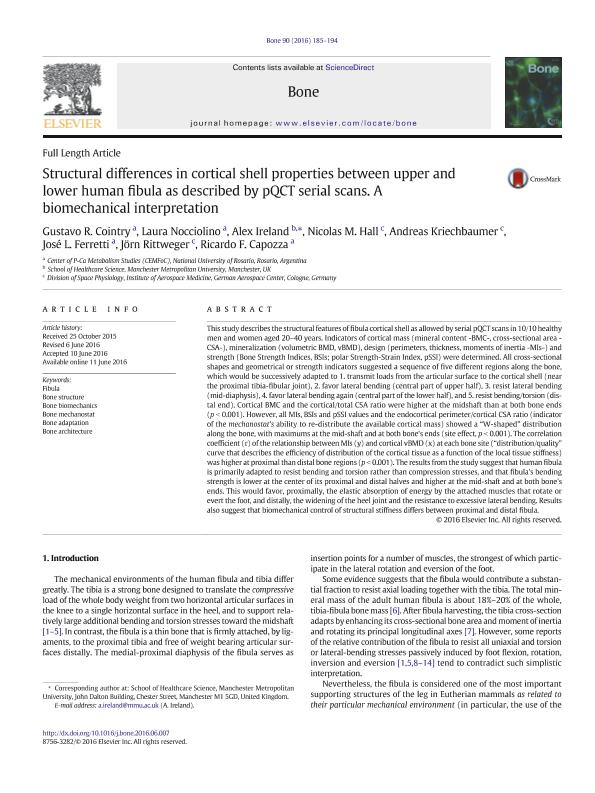Artículo
Structural differences in cortical shell properties between upper and lower human fibula as described by pQCT serial scans. A biomechanical interpretation
Cointry, Gustavo Roberto ; Nocciolino, Laura Marcela
; Nocciolino, Laura Marcela ; Ireland, Alex; Hall, Nicolas M.; Kriechbaumer, Andreas; Ferretti, Jose Luis
; Ireland, Alex; Hall, Nicolas M.; Kriechbaumer, Andreas; Ferretti, Jose Luis ; Rittweger, Jörn; Capozza, Ricardo Francisco
; Rittweger, Jörn; Capozza, Ricardo Francisco
 ; Nocciolino, Laura Marcela
; Nocciolino, Laura Marcela ; Ireland, Alex; Hall, Nicolas M.; Kriechbaumer, Andreas; Ferretti, Jose Luis
; Ireland, Alex; Hall, Nicolas M.; Kriechbaumer, Andreas; Ferretti, Jose Luis ; Rittweger, Jörn; Capozza, Ricardo Francisco
; Rittweger, Jörn; Capozza, Ricardo Francisco
Fecha de publicación:
09/2016
Editorial:
Elsevier Science Inc
Revista:
Bone
ISSN:
8756-3282
Idioma:
Inglés
Tipo de recurso:
Artículo publicado
Clasificación temática:
Resumen
This study describes the structural features of fibula cortical shell as allowed by serial pQCT scans in 10/10 healthy men and women aged 20–40 years. Indicators of cortical mass (mineral content -BMC-, cross-sectional area -CSA-), mineralization (volumetric BMD, vBMD), design (perimeters, thickness, moments of inertia -MIs-) and strength (Bone Strength Indices, BSIs; polar Strength-Strain Index, pSSI) were determined. All cross-sectional shapes and geometrical or strength indicators suggested a sequence of five different regions along the bone, which would be successively adapted to 1. transmit loads from the articular surface to the cortical shell (near the proximal tibia-fibular joint), 2. favor lateral bending (central part of upper half), 3. resist lateral bending (mid-diaphysis), 4. favor lateral bending again (central part of the lower half), and 5. resist bending/torsion (distal end). Cortical BMC and the cortical/total CSA ratio were higher at the midshaft than at both bone ends (p < 0.001). However, all MIs, BSIs and pSSI values and the endocortical perimeter/cortical CSA ratio (indicator of the mechanostat's ability to re-distribute the available cortical mass) showed a “W-shaped” distribution along the bone, with maximums at the mid-shaft and at both bone's ends (site effect, p < 0.001). The correlation coefficient (r) of the relationship between MIs (y) and cortical vBMD (x) at each bone site (“distribution/quality” curve that describes the efficiency of distribution of the cortical tissue as a function of the local tissue stiffness) was higher at proximal than distal bone regions (p < 0.001). The results from the study suggest that human fibula is primarily adapted to resist bending and torsion rather than compression stresses, and that fibula's bending strength is lower at the center of its proximal and distal halves and higher at the mid-shaft and at both bone's ends. This would favor, proximally, the elastic absorption of energy by the attached muscles that rotate or evert the foot, and distally, the widening of the heel joint and the resistance to excessive lateral bending. Results also suggest that biomechanical control of structural stiffness differs between proximal and distal fibula.
Archivos asociados
Licencia
Identificadores
Colecciones
Articulos(CCT - ROSARIO)
Articulos de CTRO.CIENTIFICO TECNOL.CONICET - ROSARIO
Articulos de CTRO.CIENTIFICO TECNOL.CONICET - ROSARIO
Citación
Cointry, Gustavo Roberto; Nocciolino, Laura Marcela; Ireland, Alex; Hall, Nicolas M.; Kriechbaumer, Andreas; et al.; Structural differences in cortical shell properties between upper and lower human fibula as described by pQCT serial scans. A biomechanical interpretation; Elsevier Science Inc; Bone; 90; 9-2016; 185-194
Compartir
Altmétricas



